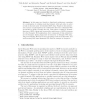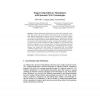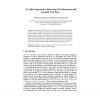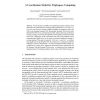ESWS
2007
Springer
14 years 5 months ago
2007
Springer
In this paper we describe a distributed architecture consisting of a combination of scripting tools that interact with each other in order to help to find and query decentralized ...
ESWS
2007
Springer
14 years 5 months ago
2007
Springer
Abstract. From a theoretical point of view, the Semantic Web is understood in terms of a stack with RDF being one of its layers. A Semantic Web application operates on the common d...
ESWS
2007
Springer
14 years 5 months ago
2007
Springer
Abstract. Social networks have recently attracted much attention for their importance to the Semantic Web. Several methods exist to extract social networks for people (particularly...
ESWS
2007
Springer
14 years 5 months ago
2007
Springer
Abstract. Software maintainers routinely have to deal with a multitude of artifacts, like source code or documents, which often end up disconnected, due to their different represen...
ESWS
2007
Springer
14 years 5 months ago
2007
Springer
The Semantic Web seems to be evolving into a property-linked web of RDF data, conceptually divorced from (but physically housed in) the hyperlinked web of HTML documents. We discus...
ESWS
2007
Springer
14 years 5 months ago
2007
Springer
Semantic Web Services (SWS) hold a lot of potential to the future of the Semantic Web. In this area, a number of tools have been developed to facilitate their definition and deploy...
ESWS
2007
Springer
14 years 5 months ago
2007
Springer
: This paper shows how technologies for Web data extraction, syndication and integration allow for new applications and services in the Business Intelligence and the Semantic Web d...
ESWS
2007
Springer
14 years 5 months ago
2007
Springer
Abstract. This paper presents a framework for the reuse and extension of existing, established vocabularies in the Semantic Web. Driven by the primary application of expert findin...
COORDINATION
2007
Springer
14 years 5 months ago
2007
Springer
Recent advances in middleware technologies propose semantics-aware tuplespaces as an instrument for coping with the requirements of scalability, heterogeneity and dynamism arising ...
CIKM
2007
Springer
14 years 5 months ago
2007
Springer
Berners-Lee’s compelling vision of a Semantic Web is hindered by a chicken-and-egg problem, which can be best solved by a bootstrapping method — creating enough structured dat...




